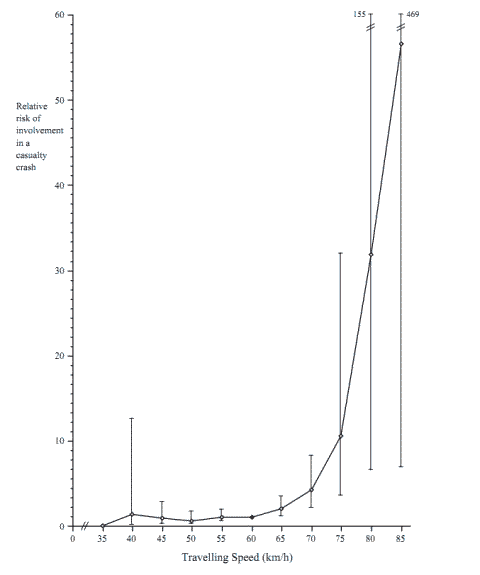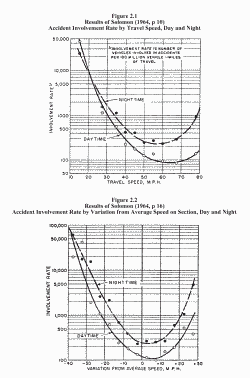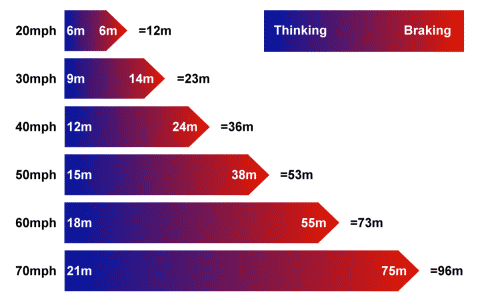On a certain web forum frequented by students, someone has written that they were stopped at 2am on the M1 doing 96mph. They want to know how many points they are likely to get.
To be fair to the person, they do appear to be sorry and worried – though I can’t help wonder if that is much of a defence when you are going at a speed which is so far above the legal limit of 70mph. After all, if they hadn’t been caught, they’d still be out there behaving in exactly the same way. But that’s not my point.
Here are some of the typical responses – poor spelling and grammar left as is – from people who apparently represent the future. I will discuss the points highlighted with superscripts later:
thats pretty unlucky because my friend was on there on sunday and clocked up to 146mph and never even saw a, police car.
…96 at 2AM on the countries best motorway. TBH, for me, should be legal. Cars have minor stopping distances1 and amazing technology…
Tbh it’s ridiculous that you even get pulled for that at 2am in the morning.
I’ve done a lot of driving around that time, and there are hardly any other people on the motorway2.
It’s not as if you could harm other people…
…Oh, and 100mph.. big boy!! Its a bad ride if the bike doesnt touch 100 at least once on a ride out, and it’ll get there in about 5 seconds if I ask nicely. My licence is clean as well3.
From 100 mph my bike will stop quicker than most cars from 70… The bike is far far more agile than cars at speed due to the small amount of weight which has to change direction. My vision and road awareness is better than most car drivers4.
96 mph is nothing, last time few times iv been driving iv done 104mph on both the M40 and the A38. The only danger here is that my car is only a 0.9 engine and the whole thing starts vibrating like itl fall apart at any second5. Iv also been caught for speeding after half a year driving, a year and a half ago doing 50ish through a 30 in a place called milford common near stafford and i got three points, although in fairness to me, it was one of those 50 areas which is suddenly a 30 for about 500m.
Also, an excuse iv used before when cautioned by an officer is that I had a nut allergy6 and i had to get to a hospital quickly or id die. That works, so try it out!!!
It’s safe to go well over 100 at 2am7, tbh.
My dad just did one for going over 100mph on the motorway; was a £60 fine and £120 for the course, and much worse a waste of 3-4 hours of your time (they really take back the time u saved by speeding), but crucially 0 points.
Oh be apologetic and sorry in court ye 8
When my mate did it, He didn’t even bother stopping for the popo, Lol he got a fine and 6 month driving ban 9
The very first quote just illustrates the mentalities of these people. At best, they are a few months out of nappies, and it is all one big boast for them. I should point out, of course, that not all young drivers are like this – but the ones that are certainly screw things up for the rest.

Even if they try and argue their corner (1), they are frequently just wrong. This character reckons that cars have “minor stopping distances”. Well, at 96mph the overall stopping distance would be around 560 feet, or 170 metres (at best). That’s about 40 car lengths, or about 100 bicycle lengths, or over 500 pedestrian lengths… it would take you nearly 3 minutes to walk that far! Hardly a “minor” distance, is it?
Then there is the frequent comment (2) that it is “quiet” at 2am (or whenever), and at those times you should be allowed to do whatever speed you wish. I’m sure that fog, unlit sections of road, debris on the carriageway, potholes, foxes, deer, broken down vehicles, other drivers who don’t realise how fast the prat behind is going and so pull out, and so on all cease to be a factor at 2am in the morning. Or not, as the case may be. And this same idiot goes on to say that “it’s not as if you could harm other people”. And another one (7) states that going at that speed at 2am is “safe”.
As well as the general stupidity of many of the younger driving generation, there is always one who stands out as more stupid than the rest (3). The fact he is also a motorbike rider is surely just a coincidence..? He brags about doing 100mph regularly, otherwise it is a “bad ride”, and he is serious. He also brags about having a clean licence, as if this means what he is doing is somehow OK. He also makes the ridiculous statement (4) about his bike being “more agile” than a car and himself having better road awareness than anyone else.
Another boaster (5) even provides location information about his achievements. He makes it clear he has been caught before on several occasions, and has even lied (6) to avoid prosecution. If the police look in, I’d suggest following that one up because many of these people really shouldn’t be driving, and a chance to remove one of them from the roads without having to go outside ought to be appealing to them.
Yet another boaster (8) provides tips on how to behave in court to get a softer sentence. His father has recently been prosecuted for doing over 100mph on the motorway, so he obviously provides a superb role model for this little cretin.
And finally, another boaster (9) – who is obviously impressed by the impetuosity of his friend, who was fined and banned for “doing it” (“it” presumably being driving at 100mph or more).

What is important to realise here is that not a single one of these morons will have been taught to drive like that. They behave like this through choice, and when they start taking lessons many of them just yearn for the day they’ll be able to break free of the leash and go and behave like prats, under the impression that it’s cool and boastworthy. This is where the authorities are so far out of touch with reality that you really do despair. They think that things like forcing the instructor to sit in on tests is going to alter the way people choose to behave. They think that suddenly calling driving instruction “coaching” will sort out the problems, and then idiots who will gladly jump on any bandwagon that they think makes being an ADI something that it isn’t – with buzzwords like “life coaching”, “life skills”, “client-centred learning”, and so on – almost wet themselves trying to peddle their “enhanced” services as a result.
Going back to Mr Fantastic Motorbike Rider who I quoted above, he is typical of the vast majority of his kind – and by “kind”, I mean young motorcycle riders and motorists. He’s the best at everything, knows more than everyone else (even people who are experts), has faster reactions than Superman, and his bike is almost as good – apparently being able to go from 100-0mph over what would appear to be about 10m, if you believe his bullshit. He says in another one of his posts:
Doing 96mph on its own presents no more risk than doing 70mph. The problem comes from other traffic, and the weather/road conditions. I dont like your immediate assumption that because the speed is X it is so much more dangerous than speed Y. Not true. You could very very easily get conditions which are safer at 90, than different conditions at 70. For example a busy road with occasional slow moving traffic and heavy rain at 70mph is more dangerous than doing 100 down an empty 3 lane motorway in clear, dry conditions.
This is actually frightening. That someone so unintelligent should be allowed to drive a motor vehicle of any kind, believing that driving at 100mph is no more dangerous than driving at 70mph. To make matters worse, he is echoing some of the idiotic rhetoric that certain anorak advanced driving groups have been advocating in order to flex their political muscle.
I’ve never had to look this up, but I have always known that having an accident increases in severity the faster you are going. It’s just the application of simple physical laws – like a pedestrian colliding with a post can result in anything from embarrassment (if they just step into it) to a hospital stay (if they run into it and knock themselves out).

If you lose control of a car at 70mph you might spin, bounce off the barrier, and even roll the car over (which is obviously bad enough); but lose control at 100mph and you’re likely to go through the barrier, or over it, and into the path of other traffic, barrel-roll down the embankment, and probably disintegrate the car as you do it. People will be sellotaping flowers with your name on them to lamp posts. This is because there is more energy to get rid of before you stop.
But that’s not all there is to it. There are the small matters of reaction time and control even before the accident actually occurs.
The faster you’re traveling, the more difficult it is to keep the vehicle under control – this is yet again down to simple laws of physics. You see, if you are driving at 30mph on a typical road, in typical conditions, in a typical car, and you suddenly steer to avoid a pothole or something, the car will simply deviate in the direction you steer. At 70mph the borderline between keeping control and losing it is much closer because there is sufficient energy for a skid. At 100mph there is more than enough energy for a skid and even a slight overreaction could lead to loss of control – someone pulling out who doesn’t realise that you’re caning it, for example.
To make matters worse, further simple physics means that the faster you approach a hazard the less time you have to think about it. Adding a little human biology makes the risk of error greater the less time you have to think. At 30mph, even if you hit a pothole you’d not lose control. At 70mph, you’d have time to steer around it. At 100mph – with all the other things going on in your head – you probably wouldn’t even see it.
This has turned into a long article. I have some scientific data to discuss, so I’ll put it in a separate post (which is here).

















